Around the Falco Patch
![]()
Around the Falco Patch |
|
by Alfred Scott
This article appeared in the December 1987 Falco Builders Letter. |
Farmerville
The Falco was smooth and solid, but a quiet sense of terror swept over me
as the horrible situation came to me. We were going 282 mph-42 mph over
the red line-and the pilot didn't even know it.
An hour before I had arrived at the SF.260 fly-in at Farmerville, Louisiana. There are nearly 40 of the big-iron Italian machines in the country now, and each year the truly insane owners descend on this northern Lousiana airport for two glorious days of pig-out on Frati airplanes.
Blame it all on Homer Woodard, the gentle, slow-talking host of the event. Homer is the chairman of the local bank, and while most of the oil-patch banks are struggling with bad loans Homer's isn't. Over the years, Homer has owned a variety of airplanes, but since the SF.260 came into his life, the others have either been sold or are sitting out in the weeds. The Marchetti, he once said, "is the nicest thing I ever did for myself."
Until recently Homer had two of them, one just to "fix up and sell" and to keep him flying while he put a new engine in the other. And Lordy, what an engine he stuffed in that airplane! It started out as a fuel injected 300 hp Aerostar engine, but by the time High Performance Engines had overhauled, polished, ported and balanced the engine, it put out 340 hp.
It's an awesome sight to see Homer take off in the big-engine SF.260. The acceleration is rapid, and the airplane bellows by with a loud, brassy engine note that could never be mistaken for an ordinary 260 hp engine. It's equally startling to turn and see Homer standing next to you watching the whole thing.
"How the devil did you do that, Homer?"
"No. I'm Huey." It's Homer's identical twin brother.
The sky overhead was abuzz with SF.260s, which exhibited a curious behavior. Any lone SF.260 was quickly joined by others which flew in formation-like ducks. They were all flying like that, never going anywhere in particular, but there were always others obediently flying along side. While I was watching this marsh bird behavior, a red Falco with a blaze of white down the side appeared overhead. Karl and Shirley Hansen circled and landed.
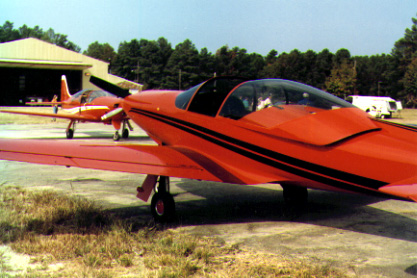
A combination of events brought three Falcos to Farmerville. A year earlier I had taken my old Messerschmitt Monsun to Fox 51 for Frank Strickler to sell, and within a month the airplane was grounded. A flying club in Germany had demonstrated once again that a metal airplane will fatigue and break from repetitive overstressing. In an act of incomparable stupidity, the FAA grounded the entire fleet and then required an exhaustive $1,500.00 inspection in Philadelphia to check the wing spar carry-through for fatigue. To no one's surprise, no sign of fatigue has been found, but having grounded the fleet the only way for the FAA to save face was to order the silly inspection. All this because one abused airplane broke. More Bonanzas have suffered in-flight structural failures than Messerschmitt Monsuns have been built!
The ultimate bureaucratic idiocy befell one owner who had recently suffered a fuel exhaustion accident. He had just replaced the main spar carry-through and had not even flown the airplane when the inspection order was issued. Before he can fly his plane, he must inspect the new carry-through for fatigue. He's appealing and arguing, but his reasoning stands no chance of prevailing.
So I had to get the Messerschmitt back to Frank in Texas. Karl Hansen had decided to see if Frank could get his price for his Falco, and I thought that a weekend of playing with Falcos and SF.260s might be a pleasant change. Al Aitken flew the Messerschmitt. I took the Corporate Disgrace. Karl flew in from California, and Pawel Kwiecinski said he'd come, too.
I had never flown in Karl's Falco and was anxious to try it out. Before the sun went down, we decided to take it up for a short flight. Karl put me in the left seat, and we fired it up. Karl has increased the rake of the seat for more headroom, and I found it slightly awkward. Not only do you sit at an uncomfortable angle, but the throttle and flap switch are nearly out of reach, even for a long-armed baboon like me.
My old Falco has a single heel brake and an enormous amount of slop in the ground steering. In contrast, I found the ground handling of Karl's Falco a vast improvement. Ground handling does not get any better than this, and if you have a problem on your first time out in a Falco, it is because the airplane actually goes where you point it with no delay.
On takeoff, my Falco lumbers along for an eternity before the tired old 150 and the inefficient cruise prop finally get it up to flying speed. It's a whole new ball game with a 160 hp engine and a constant speed prop. Shove in the throttle, and you charge down the runway and lift off with such authority that it's difficult to believe that the engine and airframe are both made in America.
With the gear and flaps up, we throttled back and set up a cruise climb. I was just flying along enjoying the scenery when Karl said, "Look at the airspeed." 150 knots! The Corporate Disgrace can only reach that in a power-on dive.
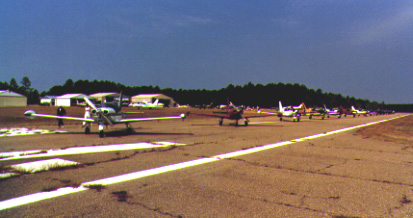
As we circled for altitude, I remembered that an SF.260 was in the air. Gary Fritzler was up getting reacquainted with his airplane after a year's absence. His nose gear collapsed at Oshkosh '86, and the plane had just been repaired. With a number of speed mods, turbochargers, intercoolers and a High Performance engine, Gary's 260 is the fastest of them all, so I just had to dare him to a race.
We slowed down and circled over the lake while Gary formed up on us. He slid along our right wing, and then we poured on the coals. At the start Gary was going a little faster so he moved ahead slightly until we got up to speed. Now Gary was not interested in seeing a Falco beat him, so he did what any self-respecting pilot would do-he cheated! With his turbochargers, he had the advantage at higher altitude, so he put us into a climb and kept cranking in the boost. Before we called it off, we had gained about 2,000 feet.
Nobody claimed victory, but it was apparent to all of us that the two airplanes were very close in performance. From what I saw, it appeared that Gary was pulling away from us a little, and Gary later said he thought the two planes would be very close in speed at lower altitudes.
Like a lonesome duck, we closed up with Gary and flew in formation. Karl Hansen, in the right seat, was flying the plane, and I was impressed with how well he flew formation. With the prop still at 2,700 rpm, the plane responded quickly to his power changes. We were in close formation, and Karl settled into the regimen of formation flying-left hand on the throttle, right hand on the stick and eyes glued on the other airplane.
It was a lovely sight. The sun had become an orange ball on the horizon, and it bathed us with a warm light. In this light, the afternoon haze became a brown murk, and the terrain below was now in shadows and difficult to see. I suggested to Gary that we do a low pass over the airfield. He lowered the nose, and we slid down toward the dark slice in the piney woods.
I glanced at the airspeed indicator. What is this? The needle was on the left side of the gauge, and it was moving. I saw it go by the red line, through 220 knots, and then it hit something and stopped moving. Wait-a-minute! Karl! I said something to Karl about being over red line, but he was so intent on flying that he only stirred and grunted like a half-asleep drunk.
You do not react as quickly as you might think to such situations. Had it been my own plane I would have reacted more quickly. I am accustomed to the panel and to the instruments. In my own airplane a glance at the indicator is all I need, but in Karl's Falco I hesitated. Am I really seeing what I think I'm seeing? I have no sense of the time it took for me to realize what was happening and then to do something about it. I see it all in slow motion.
I don't need to be told the danger of what we are doing. I know that we are dancing with flutter, I know that all airplanes will flutter at some speed, and when they do they usually break apart. We are flying faster than the plane was designed to fly, faster than it has ever been tested, and I know that we could die at any moment. I realize what is happening, and I am afraid.
I tell Karl we are going too fast, but he grunts and keeps on flying. He doesn't seem to understand, and Gary doesn't know. I push the button on the stick and tell Gary we're over the red line and to please slow down. He starts to slow down. "What's your red line?" I tell him it's 208 knots. "What's that in miles per hour?" "Two forty." Our plane moves closer to the SF.260, and I see that our wing is moving behind the tip tank, into the disturbed air of his wing. That could excite aileron flutter, so I yell something to Karl about keeping our wing away from his. He manages a flustered grunt, and the Falco moves slightly to the left.
I began to relax after the airspeed moved under 200 knots, and I noticed that my hands were drenched with sweat. They were still wet when we landed fifteen minutes later. I studied the airspeed indicator and decided the gauge was probably indicating 230 knots when it hit the stop. At a density altitude of 4,000 feet, that calculated out to a true airspeed of 282 mph. Later Gary Fritzler said he was indicating 265 mph when I called him to slow down, so maybe we were going 283 mph. Who knows? But flutter is a function of true airspeed, and we had flown the Falco 42 mph faster than the red line speed. The Falco's design speed is 264 mph and years ago some brave, parachute-equipped Italian test pilot flew the Falco to that speed for the certification. We had flown 18 mph faster.
We flew over the field and flushed up two more ducks, which immediately formed on our left. This did nothing to contribute to dry palms. It was my first ride in a formation flight of four, and we were sandwiched between two on our left and one on our right. While such a flight of four might look smooth and graceful from the ground, there is a surprising amount of relative movement among the airplanes. I also had no idea how skilled the other two pilots were.
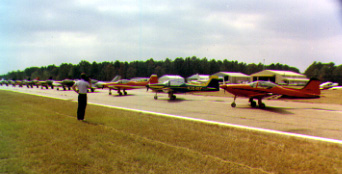
But as you can see, we made it. We landed and while I headed toward the beer cooler to calm my nerves after our high speed let-down, the unfailingly cheerful Hansen chuckled, "You can always trust a tree." Maybe, but freedom from flutter has more to do with design, engineering, controls balancing and cable tension. If it's true that luck is a byproduct of design, then I'll just accept it as luck.
There are only three hangars at the Farmerville airport, and all three are Homer's. The airport operator has long since closed up shop and moved on to other lost causes. The SF.260 gang was a lively bunch who had taken up residence in the largest hangar. "Siai", a fluffy bedroom slipper of a dog-what some call a "drop-kick dog"-is the group's mascot, and he bounded joyfully around the assembled group.
A group mascot is one thing, but this squadron actually had their own undertaker. The friendly fellow who kept following us around, buying everyone drinks in the bar and pouring us coffee in the morning, turned out to be the local mortician who said he just liked to hang around pilots. Maybe, but it made me nervous.
Karl Hansen put the canopy cover on his Falco saying that he likes to think of the Falco as the female of the species and with those big Marchettis around, he thought he'd better cover her up-you know how Italian men are. It didn't do a bit of good. The next morning we arrived to find another red Falco out there. It turned out to be only Pawel Kwiecinski's new bird.
There was a big barbeque in the hangar on Friday night, Homer's two-alarm armadillo chili in the hangar for Saturday lunch and a banquet at the local Holiday Inn on Saturday night. In between we all took turns trading rides. It was like having your own personal Oshkosh, but without the fiberglass fishbait. More fun, too.
There were 19 SF.260s and 3 Falcos there, and we lined them all up on the runway and took pictures. One ex- Marchetti owner showed up in his Beech Duke and rolled it over the field without spilling a drop of scotch in the back. I was impressed at how well the 160 hp Falcos held their own in formation flying with the 260 hp SIAI Marchetti. The planes are so similar you had to look twice to tell if it's a Falco or SF.260 taxiing by.
One thing the SF.260 definitely has on the Falco is the sound of the engine. The Falco has a stacatto bark, but the six-cylinder engine has an almost-musical tone. There is a husband/wife matched pair of Falcos in Italy, but none in the U.S. Jack and Cindy Rouse have their matched pair of blue SF.260s. One of the weekend's events was to assign all pilots CB-style handles, like "Magnum" and "Turbo". I never did understand why Cindy objected to my suggestion of "Tip Tanks".
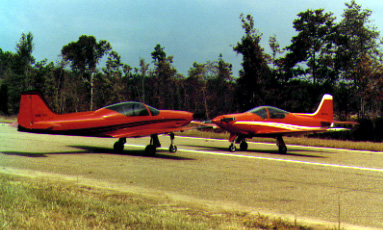
Pawel Kwiecinski and Karl Hansen's Falcos face off.
I was interested to hear what Frank Strickler thought of Karl Hansen's Falco. Many of you have met Frank at our annual dinner at Oshkosh. He's the balding little feller with bifocals and a 'Texshus' drawl who hails from "Denton, America". That's just north of Dallas, and Frank sells SF.260s.
Over the years, there have been a number of people who have attempted to sell SIAI Marchetti SF.260s in the U.S. All except Strickler have failed. The seemingly simple proposition of importing aircraft to the U.S. has daunted an embarrassing collection of huge European companies. Frank Strickler succeeds, I suppose, because of his unbridled enthusiasm for the qualities of the Frati machine and his expert knowledge of the airplane. He has a loyal following among the owners of the airplanes. Of the 39 SF.260s in the country, Frank has sold all but seven to the original owners, and he has resold ten of them two or three times. He has even sold them in New Zealand and Germany, and there are three already-sold SF.260s on the way.
Despite his slight stature, Frank Strickler has a forceful presence by virtue of his commanding voice and considerable verbal skills. A speech by Frank Strickler is an event unexplained by modern science--it has no mass, and yet it has inertia. When you and I find ourselves in a sentence that we cannot finish, we stutter and stumble until we can find no way to extricate ourselves, and we begin again. There are no blind verbal canyons for Frank Strickler. In the same situation, his voice goes into a low grumble, but he plows on. He will twist, maneuver, reverse course--his voice rising and falling--then roll, strafe, bank, and peel out. Just when you thought he was going to crash and burn.
Frank Strickler is a Mark Twain riverboat captain caught in an impersonal world--now a pilot for American Airlines, and he flew all the jet stuff in the Air Force before that. Between sorties flying fat Americans between major cities, Frank can be found at his Fox 51 Ltd. One walk through his hangar says it all. There are two P-51s, a a couple of T-6s, a rare Bücker Jungmann, a Beech 18, five or six SF.260s and a red Falco. The Cessnas and Pipers are parked outside.
I knew Frank was going to love the Falco, but I had to hear it for myself. After he flew Karl Hansen's Falco, I called him to get a report. "It's wonderful. It's so nice. It flies perfect. The only thing I don't like about the airplane is those grips Karl put on the control sticks hit the lights on the panel at full forward stick. It goes like a scalded rabbit. What's the cruise setting on that engine? I was just tooling around at 24/24 at three thousand, and it was indicating 170 knots. You can loop it from straight and level. You remember that thing James Gilbert wrote about the first time you fly a Frati airplane? It's really true."
Urbanna
The Great Oyster Fly-In found the east coast blanketed in smoke from forest
fires. In the morning the smoke had reduced visibility to 800 and a half,
but it gradually improved during the day. Al Eynon and Ron Keilin flew their
SF.260s from Ohio. They found the field with difficulty and then lost sight
of the runway on base. Paul Sterbutzel flew his SF.260 in from northern
Virginia.
The Corporate Disgrace was the only Falco in attendance. Jim DeAngelo had the good sense never to break ground, but Jonas Dovydenas made it as far as the Statue of Liberty in a Super Cub, but the visibility had fallen to a half mile and the headwinds were fierce. Pawel Kwiecinski and Irek Mikolajczyk made it as far as Ohio and couldn't get over the mountains. With only a hand-held battery-powered nav radio, they decided to do it next year. The Wilkinsons arrived by noon. Terry Smith flew in from Pennsylvania. The Wieczoreks and Aitkens arrived by four-wheel vehicles.
The big surprise was to find Francis and Wanda Dahlman there. After a year's bout with bone marrow cancer, their daughter had died recently, and they wanted to get out of the house. Francis brought along a present for me, a glass-topped coffee table made from a Falco station one fuselage frame. It really makes a lovely table, particularly when you put a lamp on it so that the shadows show the depth. The fuselage frame was a reject since one of the glue joints had hardened before Francis could get a clamp on it. Francis couldn't bear to throw the frame away, and it hung on the wall of his shop for a year until he hit upon the idea of making a table of it.
There was a record crowd of 45,000 people at the Urbanna Oyster Festival. That's a lot for the tiny town of five hundred permanent residents. We had 16 airplanes in all at the airstrip, but with all of the smoke there wasn't any flying going on.
Which was a major disappointment to Jimmy Stanley, my 12-year-old nephew. For his birthday last spring, Meredith and I gave him a ride in the Falco. Somehow, I had never gotten around to delivering, and in truth I had forgotten all about it. Not Jimmy. The walls of his bedroom are covered with pictures of airplanes and for the past six months he has been dreaming about the ride. He and his family were staying with us that weekend, and the main event was to be Jimmy's big ride. Smoked out.
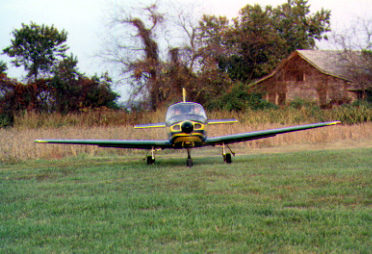
The Corporate Disgrace at Rosegill Farm airstrip.
But then late in the afternoon the smoke cleared. "How about it, Jimmy? Want to give it a try?" Jimmy gave me a military "Yes, Sir!", and the veteran of sixteen viewings of Top Gun and I swaggered over toward the Falco. I remembered my own first experience with an airplane at his age-watching my uncle fly off to The Big City in a shiny red Staggerwing that charged down the grass, slipped gracefully into the air and then disappeared in the distance, and how for months afterward I climbed the bales in our hay barn and thought about how wonderful it must be to actually fly in a plane like that.
From the time we strapped in, Jimmy got a grin on his face that never left him. At some point on a first ride there is a moment of uncertainty, usually on the first barrel roll, when you never know if you are going to scare your passenger. This never came with Jimmy, his grin took a permanent set. We rolled, we looped, and we strafed up and down the runway right there in front of Mom, Dad, Christopher and George. The river became an obstacle course, and we pulled mightly as we carved our way through the chicanes and switchbacks.
A white SF.260 fired up and started his takeoff run just as we were strafing from the opposite end. It was reported that "Aunt Meredith" did not react well to the sight of these two planes approaching each other at high speed. It only seemed right to make things look dramatic, and Jimmy loved it. If we had crashed in the woods the rescue team would have peeled a pair of smiling lips off one of the trees.
We formed up on the SF.260 and flew in formation, just like they do in Top Gun. We ran the obstacle course a couple of more times, landed, and then I watched as Jimmy hitched up his blue jeans and strode back across the grass strip. It was the ride every boy should have. Jimmy and his family had to leave, and they then spent the next two hours saying goodbye.